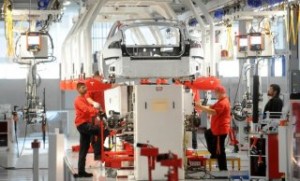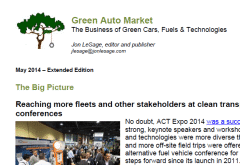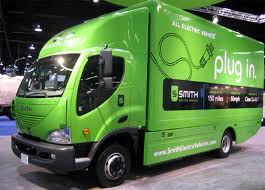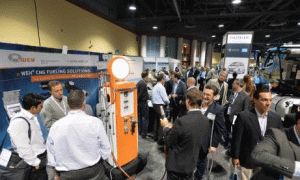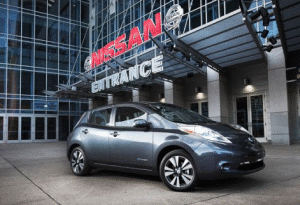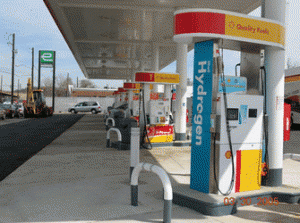By Mike Sheldrick, Senior Editor, Fleet Management Weekly
 Fresh from his accepting the Environmental Protection Agency’s 2014 Clean Air Excellence Award for innovative programs on behalf of Florida Power & Light Co., we caught up with Claude Masters, NAFA President and FPL’s Manager of Vehicle Acquisition and Fuel. We found that Claude’s longtime enthusiasm for the potential of electric vehicles to save energy and contribute to our energy independence remains undimmed — in fact, even brighter.
Fresh from his accepting the Environmental Protection Agency’s 2014 Clean Air Excellence Award for innovative programs on behalf of Florida Power & Light Co., we caught up with Claude Masters, NAFA President and FPL’s Manager of Vehicle Acquisition and Fuel. We found that Claude’s longtime enthusiasm for the potential of electric vehicles to save energy and contribute to our energy independence remains undimmed — in fact, even brighter.
Tell us about some of the electric vehicle initiatives that are in the forefront right now at Florida Power & Light Co.
Our initiatives are also important for the industry as well: helping move along the fleet electrification process for not just our fleet, but for the country and the industry as a whole.
How electricity is produced and used is a large component of the effort we are making to achieve energy independence. I serve on an Edison Electric Institute (EEI) committee that is writing a white paper for the CEOs of investor-owned electric companies across the country that will help them understand what fleet electrification means and why it is important to them.
Vehicle electrification is further along than many think. We already have a generation infrastructure. What is not fully developed yet is the final attachment point. But that distribution network is being worked on very actively. For example, you see a lot of media related articles about what Tesla is doing. Florida Power & Light has actually helped the company with the installation of a “supercharger highway” in Florida, and we look forward to doing more of that.
If you look at the electric vehicles that we have in place today, they have played an important role in helping the whole industry get to where it needs to be. For the OEMs to meet future CAFE standards, electric or plug-in hybrid electric vehicles have to be a major part of the OEMs plans. There is just no other way for them to meet those numbers without it.
There have been substantial improvements in these vehicles. Take hybrids, for example. Some early models didn’t even have electric air conditioning systems. With some of the early offerings, you had to take it out of “economy mode” to run the air conditioner because there wasn’t enough volume in that market space to drive development of a cost effective electric air conditioner. Today that is a standard feature on hybrid vehicles. Moreover, all of the ancillary components — power steering, power brakes, etc., that were formerly driven off the engine are being electrified. Removing that “parasitic loss” saves 40 to 65 horsepower, making the engine that much more fuel-efficient.
In today’s truck market, most of the heavy over-the-road tractors still have belt-driven water pumps, belt-driven air conditioners, power steering, etc. Eventually, electrification of these ancillary components will migrate into the heavy truck market and you will see the same thing happen. Over-the-road trucks and tractors can start downsizing their engines to make them more fuel efficient. Measured over the size of that fleet, it will be a big deal.
It’s true that we need better, lower-cost batteries. Nevertheless, with today’s technology, Tesla has proved that electric cars can be successful. Tesla may not have fully solved the range anxiety issue but they have certainly diminished it greatly. It’s not uncommon in West Palm Beach or Los Angeles to go to an upscale mall or restaurant and see two or three Teslas in the parking lot at the same time. That tells you that the acceptance of those vehicles is here. Granted, not everybody can afford a Tesla today but they are certainly not any more expensive than other premium cars.
Do you think Tesla has significant proprietary technology or are there other advanced battery technologies being developed?
I don’t profess to be an expert on it but what I do know about the military and the defense industry is that every day their reliance on high performance batteries is increasing. There is always going to be a market for some type of advanced battery. They need to get lighter and they need to get more energy dense. It is like a race, much like any other business: whatever chemistry you use to build the battery that provides the highest energy density at the lowest price will be the winner.
If somebody comes up with an inexpensive, relatively high energy-density battery two or three years from now, I think they will continue to work on that and refine it, and keep playing with chemistries until we get the one that is the right one for the industry. Just like cell phones, the technology changes so fast that, four years from now, we will look at it and say, “This thing is archaic. I can’t survive with this version.”
If you are just building batteries for cars you are probably not going to stay in business very long. If you look at a lot of the larger, successful battery manufacturers they are building batteries not only for the automotive industry, but for the aerospace industry, the medical industry, the solar industry, etc. That explains Tesla’s deal with Panasonic to jointly produce batteries.
As fleets become more electrified, what will be the effect on maintenance costs and residuals?
Most people don’t initially grasp the changes in residuals but when you talk about it in detail then it starts to make more sense. The reason why it is hard to set residuals on battery/electric vehicles today is because there’s so much debate about what the true life cycle of a battery is. Most manufacturers warranty their batteries from eight-to-ten years. That has more to do with the charge cycles than it has to do with actual age of the battery.
The battery-life studies that the manufacturers do run like this: They cycle it, and every full discharge and recharge is considered a cycle. Most batteries are approximated to live between 3,000 and 4,000 cycles. If you used your car 300 days a year times ten years that is 3,000 cycles. They feel very confident that that battery will live for that ten year period and they feel comfortable giving you a warranty on that. Most people don’t keep a car ten years.
Let’s say that you bought a ten or eleven year old vehicle and the batteries fail on it at eleven years. What we don’t know is what battery costs are going to be in eleven years. There are a lot of studies that have been done on battery costs by doing forward projections. Almost no one will tell you what the exact number is because it is proprietary information, and nobody wants to give their competitors knowledge of what their costs are. But most of the people that I talk to that do research on this say that today’s prices for a lithium ion battery, which is what most people are using, is about $450.00 per kilowatt hour. The Ford projection for that in five to seven years can vary from $150.00 to $250.00 per kilowatt hour.
After a battery is not suitable for use in a vehicle, it hasn’t reached the end of its useful life. There are many applications, such as solar power, where they can be put to perfectly good use. Beyond that, the battery materials themselves can be recycled. A secondary market in batteries is already beginning to develop. When the Prius first came out over ten years ago, people said the Prius was not going to have any residual value because nobody is going to want to buy one. They don’t know what is going to happen to the batteries. Well, today there is a great secondary market for Prius. Its residuals are typically higher than a comparable vehicle in its class.
The one thing that everybody does agree on is that you do see a reduction in maintenance cost. But most people have not had electric vehicles in operation long enough to do a ten year comparison or comparative analysis, so that part has not been agreed upon. There are some Six Sigma tools that you can use to do projections. But, again, everybody agrees that your typical electric car has about one-third of the components of a conventional internal combustion engine vehicle. Typically you are talking about no transmission, no cooling system, and no exhaust system. On the heavier-truck side of it, the exhaust system profile for a medium- or heavy-duty truck is a big expense — $7,000-$10,000 worth of after-treatment devices on a truck that you didn’t have ten years ago. That is a big cost component.
Summarizing what we’ve talked about, can you give us your predictions for vehicle electrification?
Predictions are always dangerous, but certainly in 30 or 40 years, maybe sooner, we will probably be looking at vehicles that have electric motors to propel the vehicle, in conjunction batteries or with some type of power system such as a hydrogen cell reformer that generates the needed electricity. Electric motors —however they are powered, by batteries, or fuel cells, or even an onboard generator, have a significant edge in efficiency. In a conventional gasoline engine, only 30 to 40 percent of the energy actually makes it to the drive wheels; with an electric motor it is 100 percent. We still need higher-energy-density, lower-cost batteries.
In summary, vehicle electrification is a really big deal to our industry and to the country. I think it is going to play a major role in the transportation industry for the future, and I am going to do everything I can to help support that.
 Toyota Motor Corp. has been carefully watched by advocates of clean vehicles – its Prius became the symbol of innovation in the hybrid space even though several other competitive hybrid models were launched around that time. When Toyota made an agreement in 2010 with Tesla Motors to integrate its electric motor and batteries into the Toyota RAV4 EV, along with Toyota’s $50 million investment in Tesla and Tesla’s takeover of the shuttered NUMMI factory in Fremont, Calif., the working relationship looked very promising. It also helped strengthen Tesla’s promise to become a thriving automaker (which was also supported around that time by Daimler’s investment). The Toyota and Tesla relationship seemed to sour this month when Toyota announced that it will phase out an agreement from 2012 for Tesla to deliver 2,600 battery packs for Toyota’s electric RAV4 over three years.
Toyota Motor Corp. has been carefully watched by advocates of clean vehicles – its Prius became the symbol of innovation in the hybrid space even though several other competitive hybrid models were launched around that time. When Toyota made an agreement in 2010 with Tesla Motors to integrate its electric motor and batteries into the Toyota RAV4 EV, along with Toyota’s $50 million investment in Tesla and Tesla’s takeover of the shuttered NUMMI factory in Fremont, Calif., the working relationship looked very promising. It also helped strengthen Tesla’s promise to become a thriving automaker (which was also supported around that time by Daimler’s investment). The Toyota and Tesla relationship seemed to sour this month when Toyota announced that it will phase out an agreement from 2012 for Tesla to deliver 2,600 battery packs for Toyota’s electric RAV4 over three years.
